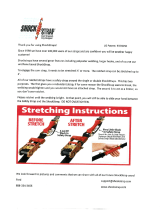
Table of Contents Rev. 10/8/2020 LLPW-CL-1560 MANUAL
Table of Contents Copyright 2020 Vestil Manufacturing Co. Page 7 of 9
RECORD OF SATISFACTORY CONDITION (THE “RECORD”)
Record the condition of the hand truck before putting it into service. Thoroughly photograph the unit from multiple
angles so that all operating mechanisms are clearly visible. Take close range photographs of the labeling applied to
the truck. Raise and lower the deck. Describe the operation of the winch. Describe sounds heard as the deck rises
and descends. Include detailed descriptions about the frame, cylinder cradles and ratchet mechanisms, rollers,
wheels, casters, carriage, mast rollers, and the lifting mechanisms (winch, cable, and pulleys). How much effort is
required to turn the winch? Collate all photographs and writings into a single file. Give the file a name that clearly
identifies it. This file is a record of the unit in satisfactory condition. Compare all inspection results to the record to
determine whether the truck is in satisfactory condition. Purely cosmetic changes, like damaged paint/powder coat are
not changes from satisfactory condition. However, touch-up paint to be applied to all affected areas as soon as
damage occurs.
INSPECTIONS & MAINTENANCE
Regular inspections and maintenance are necessary to keep the device in normal condition. Compare the results
of each inspection to the Record to determine whether the unit is satisfactory condition or requires repairs or
replacement parts. If you are uncertain whether a part requires repair or replacement, contact Technical Service for
assistance.
• Periodically lubricate moving parts.
• Keep the product clean and dry.
• Only use manufacturer-approved replacement parts.
At least once per week, inspect the following components:
1. Winch, winch mounting bracket, cable, carriage rollers, and pulley [See Using the Hand Truck on p. 6]: Cycle the
deck up and down. Listen for unusual noises and watch for binding or rough movement as the carriage moves. If
the carriage does not move smoothly or makes noise as it moves up or down the upright, apply a silicon wax or
silicon spray to the inside of the mast frame. Examine the winch. Make sure that the spool is intact and rotates
smoothly when the handle is turned. Inspect the mounting bracket. The winch should be solidly attached to the
bracket. Tighten all loose fasteners. Lower the carriage and examine the cable for reeving, stretching, thinning
portions, etc. Confirm that the pulley rotates freely and is securely fastened to the mast.
2. Frame (mast, base): Examine the frame members for damaged welds, severe rusting, cracks, bends, etc.
Remove rust with steel wool. Clean the affected areas and apply touch-up paint.
3. Cylinder cradles: Examine the ratchet straps for cuts, tears, etc. Inspect the hooks and that ratchet mechanisms.
Confirm that all parts operate normally. Tighten fasteners that attach ratchet assemblies to the cradles. Check
cradles for wear, rust, corrosion, and other types of damage.
4. Wheels, rollers, and casters: Check each wheel, caster, and roller for wobbliness, damage, and severe wear. All
should roll smoothly. Clean them to remove debris from the surfaces, if necessary.
5. Hardware: Examine the pins, bolts, nuts, etc. Tighten loose fasteners. Replace all damaged fasteners.
Maintenance: Implement a maintenance program to ensure that the lifter functions normally for as long as possible.
Page 9 of ANSI/ITSDF standard B56.10-2006, “Manually propelled high lift industrial trucks”, describes recommended
maintenance procedures. A copy of the standard is downloadable for free from the ITSDF website (
www.itsdf.org).
Apply those recommendations in conjunction with the following steps.
1. Tag the lifter, “Out of Service.”
2. Inspect the lifter as described above. If deformity, corrosion, rusting, or excessive wear of structural members is
present, permanently remove the lifter from service.
3. Remove any dirt or other matter from the cable and pulleys and other lifter surfaces.
4. Perform all other necessary adjustments and/or repairs. DO NOT modify the lifter.
5. Make a dated record of the repairs, adjustments and/or replacements made.













